Printed aprons in kitchen interior design
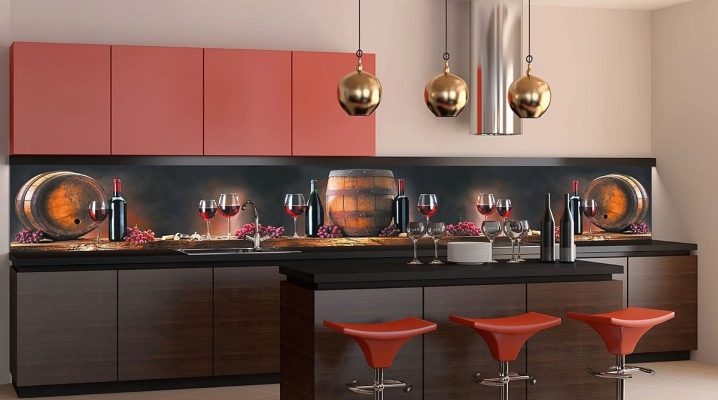
Modern kitchens are often made from solid materials. Despite the good technical equipment, outwardly they look strict, even ascetic. To revive the monotonous interior, to give it a zest, you can make an accent apron with your favorite image. The hostess will always be pleased to be in such a room, since the drawing on the wall meets her taste, interests, and mood.
Printed aprons can be tiled or applied to the glass surface. The second option looks more impressive and is often used to solve design problems in the interior. Decorative glass panels with a print (image) applied to them are called "skinned". In addition to aprons in the kitchen, they are used as a wall panel or for decorating furniture facades.
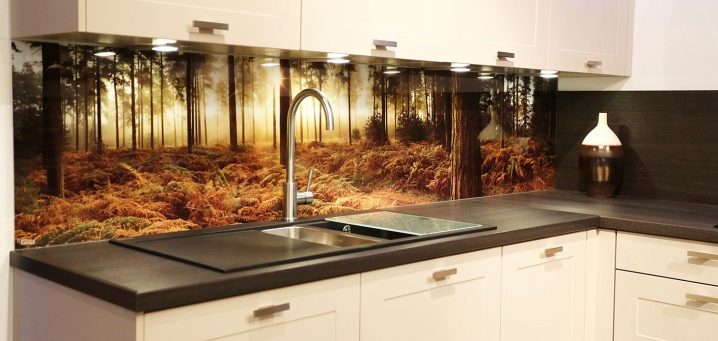
Based on ceramic tiles
With the advent of digital technologies, a new and interesting direction has emerged in the design of finishing materials - photo tiles. It has other names as well: photoceramics or photo decol. These are ordinary ceramic tiles, on the surface of which a pattern is applied using digital photo printing. You can order an exclusive image or use the catalogs offered by the company. The size of the picture depends on the wishes of the customer: it can be located on one large tile or make a panel for the entire area of the apron - in this case, the image will be divided into fragments for each tile.
You can apply a picture in several ways: using the Decal technique or sublimation.
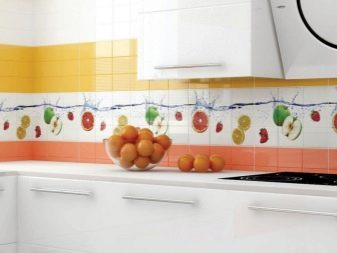
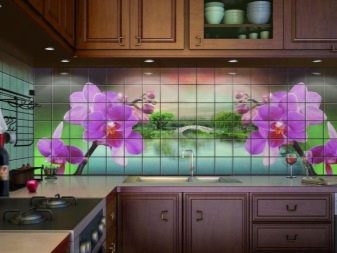
Technique Decal
This technology uses high-temperature pattern firing, which uses organic and inorganic dyes. Under the influence of high temperatures, organic dyes burn out, and inorganic ones are baked on ceramic tiles, drawing an image.
The Decal technique is a painstaking manual process. To make a panel of medium size, it will take from one to two weeks (depending on the complexity of the order).
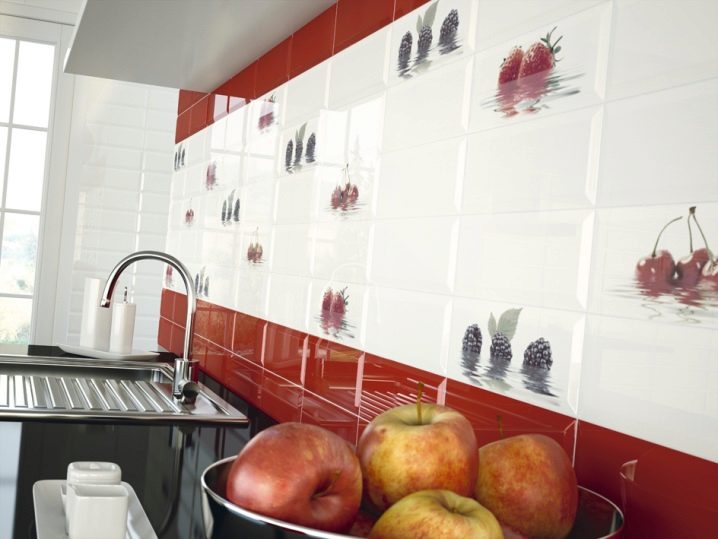
The advantages of decal tiles are as follows:
- durability;
- durability - the material is not "afraid" of scratches and other mechanical damage;
- easy to clean (even using chemicals);
- UV resistant, does not fade.
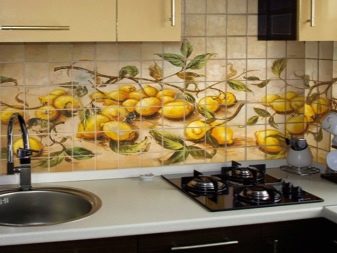
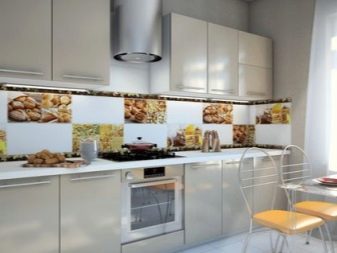
Sublimation
Sublimation printing is a method of indirect printing. Initially, using digital printing, the drawing is transferred to paper. Under the influence of temperature, the paint from the workpiece penetrates onto the previously prepared polymer coating of the tile. The sublimation method is also used to apply an image to dishes, metal, plastic, glass.
The advantages of the method include the saturation of the color gamut transmission, the resistance of the pattern to high temperatures, ultraviolet light, mechanical and chemical influences.
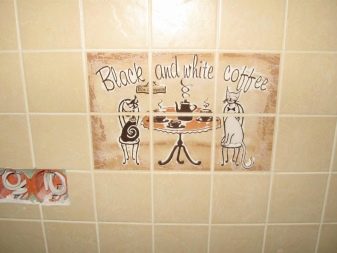
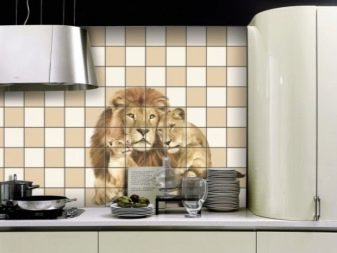
Glass based
One of the latest technologies is the use of photo-printed glass in interior design and furniture production. Not so long ago, aprons for the kitchen began to be made by a similar method.
The most popular are skinal slabs, which are assembled from two glass sheets with an image sandwiched between them. The drawing can be made by the usual method of photo printing or stereo printing.The choice of the second option will increase the cost of the product several times.
Optivite is another type of glass that is used for aprons in the kitchen. As a result of bleaching, the glass loses its bluish tint and becomes a more suitable background for images in a light tone with small traced details. The cost of such a product also exceeds the price of conventional tempered glass.
The strength and durability of the apron depends on the method of applying the image and on the thickness of the glass itself. The thicker the product, the stronger and more expensive it is. A density of 6 mm can be considered quite reliable.

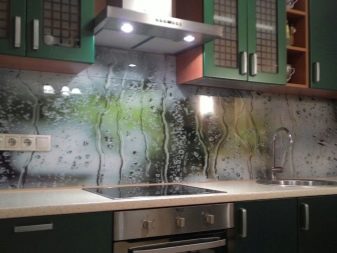
The glass product is beautiful and practical, it can decorate any kitchen. A glass apron has a lot of advantages:
- it is unusual and effective;
- has no seams;
- heat resistant;
- you can order an exclusive version (up to your photo);
- the product is strong and durable;
- it is easy to care for, which is facilitated by the smooth surface of the glass;
- resistance to moisture and household chemicals;
- glass panels are easy to assemble.
The negative aspects include the high cost of the product, as well as the impossibility of revision and reinstallation. Lamps, sockets and other additions must be thought out in advance.

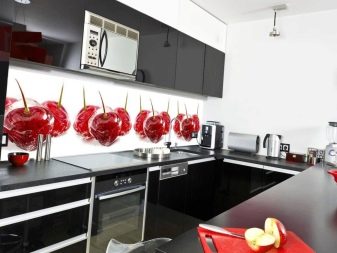
Photo printing on glass
Customized photo printing on glass will create a unique interior. But even if the drawing is selected from the catalog, an infinite number of pictures will allow you to mount an apron with a complete coincidence of the owner's taste and mood. There are different ways to digitally print glass.
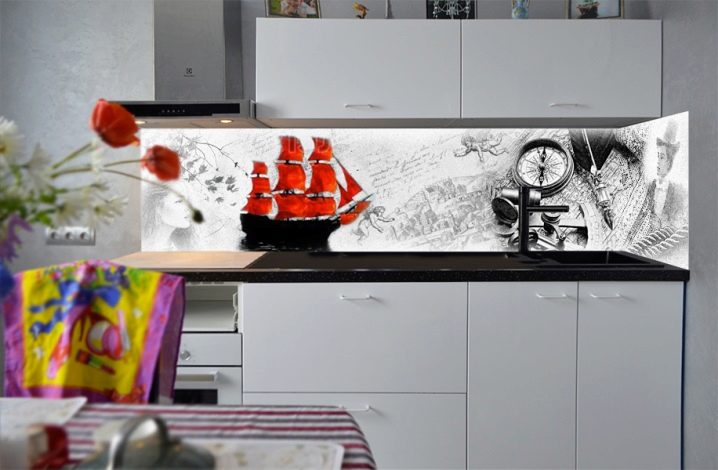
On polymer film
The simplest and cheapest is a photoprint on a polymer, vinyl film, which you just need to glue on the glass. If the surface is matte, then the pattern is placed on the front side and covered with several layers of varnish. The paints are strong enough and amenable to maintenance, but the service life of such a product will not be durable. It is much safer to place the drawing behind a transparent surface. In this case, the strength of the product will be fully dependent only on the thickness of the glass. The film applied between two tempered glasses is called skinny slabs. This is the most convenient material for creating an apron for the kitchen.
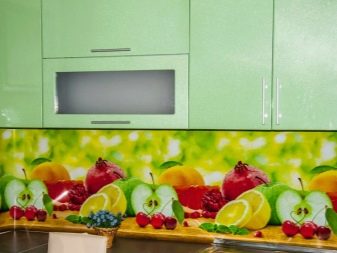
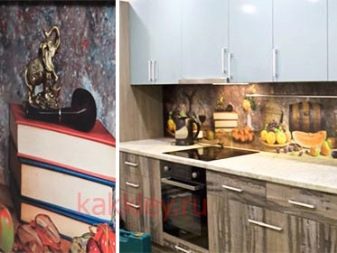
Direct action printing (UV printing)
This method is more expensive, it involves applying a pattern to the surface of glass or other smooth base with special ink. Drying, they form a reliable film that is resistant to moisture, ultraviolet light and external damage.
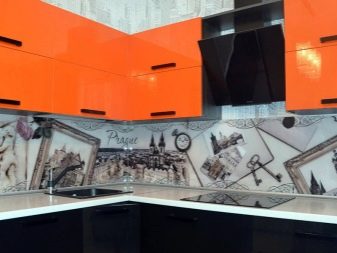

Ordering exclusive images
Digital photo printing technology has the ability to reproduce images according to the customer's material.
But it should be remembered that not every blank is suitable for the implementation of the project. It must be a high-resolution photograph (for 10x15 cm - at least 1500 pixels). Otherwise, the image on the glass will be grainy and blurry.
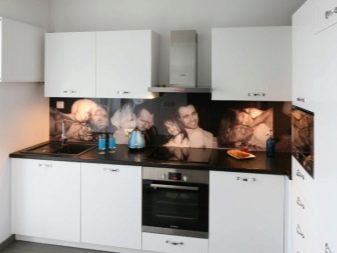
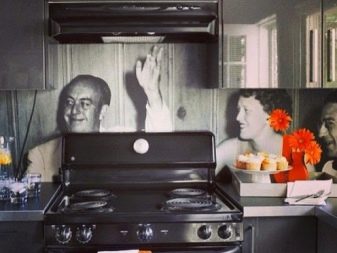
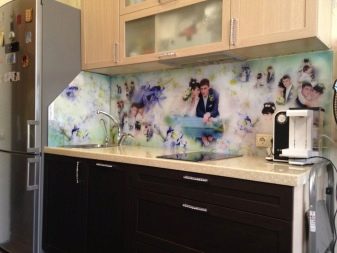
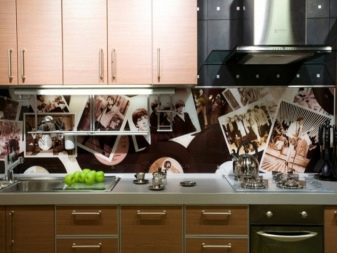
Subject theme
Often, when choosing a topic, a single criterion is used - personal preferences, which is a big mistake. Sometimes the image in the photograph does not coincide with the expected result, moreover, it is discordant with the surrounding environment. For example, if the interior is oversaturated with colors, the kitchen apron should be more calm and neutral, but match the dominant color (brown furniture is in harmony with the coffee theme). In a room with a monochromatic coating of furniture and walls, the apron may have an accent character.
In a large kitchen, macro images look good (especially if they are made in 3D technique). In a small room, you should choose a plot that expands the space: a wheat field or a sea extending beyond the horizon.

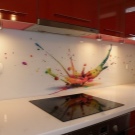

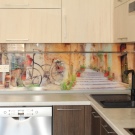
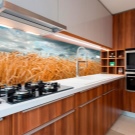
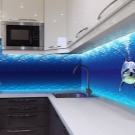
Floristics
One of the most popular themes that are used to decorate aprons. It has an endless selection of plots: daisies, poppies, roses, tulips, over which birds, butterflies, bees soar. Different shades of colors allow you to choose an apron for any kitchen furniture.
- Orchids on stones. Orchids, depending on their color, can be a bright burst of energy (red, burgundy) or delicate and romantic (white, blue). Wildlife in any form is flawlessly combined with smooth cold stones. The tonality of the apron is well matched to the general background of the kitchen.
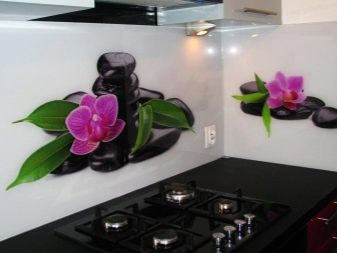
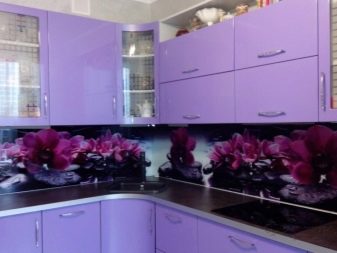
- Fruit in water. Images in this theme are presented in a wide range: from fruits immersed in the water element, to the freshness of delicate drops on the appetizing fruit peel. Salad-colored furniture goes well with green apples covered with cool dew.
As an alternative to green cuisine - fruits with a dominant shade of green, captured during the immersion. This image gives dynamics to the plot.
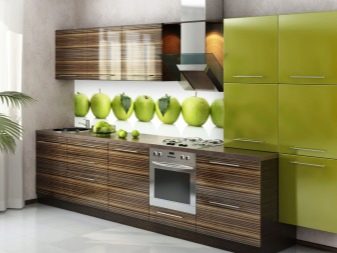
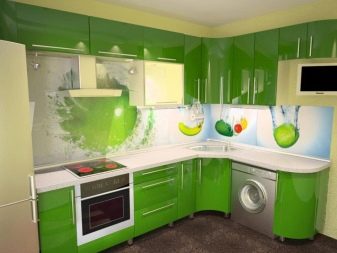
Urban themes
Cold urban plots are often used for loft, minimalism, techno styles. The city at night with a black tonality, illuminated by the lights of the windows, is especially popular. Romantic people prefer to see a piece of Paris or Venice in their kitchen.
- Night city. The plot of the night city is surprisingly embedded in the black and white kitchen in the style of minimalism. The abundance of city houses concentrates the gaze on itself and at the same time dissolves it in the dark tonality of the picture. Without a specific storyline, the room would look cold and lifeless.
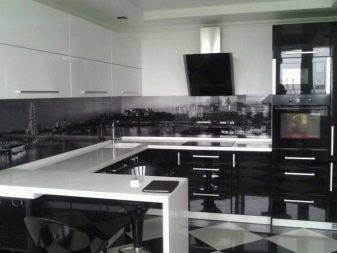
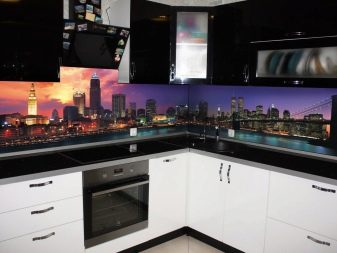
- Street Cafe. Despite the fact that the plot continues the food theme of the kitchen space, such an apron looks quite sophisticated. A cup of morning coffee with a pleasant companion takes the imagination to the quiet streets of the old city with beautiful architecture and bustle. An airy light pattern can facilitate a monotonous setting, and in a room with dark furnishings, it can play in contrast.
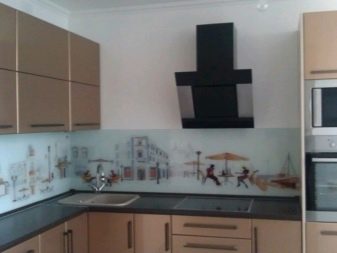
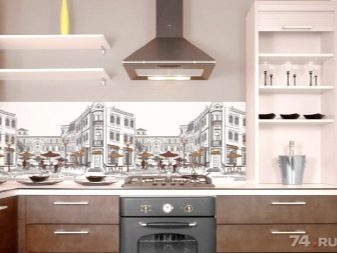
An endless variety of plots makes it possible to choose an apron for any kitchen stylization. Photo printing technology can help a small room to visually expand the space with a drawing with perspective. And for a large room - to become an accent fragment of the kitchen interior, which will attract admiring glances.
For the pros and cons of a mirrored glass apron, see the next video.













The comment was sent successfully.